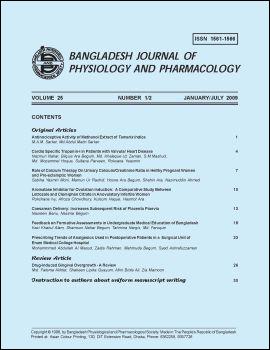Cardio Specific Troponin-I in Patients with Valvular Heart Disease
DOI:
https://doi.org/10.3329/bjpp.v25i1.5737Keywords:
Cardiospecific Troponin I, Aortic stenosisAbstract
Valvular heart disease is a common cardiac disease in our country. The valvular heart disease which we face in our day to day hospital and private practice is due to chronic sequlae of rheumatic fever. In chronic rheumatic heart disease mitral valve is affected in more than 90% of cases and aortic valve is the next most frequently affected valve. This study was done to evaluate the association of Cardio specific TroponinI I (cTnI) and valvular heart disease. Cross sectional study was conducted among 60 valvular heart disease patients and 30 control groups. A structured questioner and checklist was used to collect data through face to face interview, echocardiography findings and laboratory estimation of cTnI.
A total 60 patients and 30 healthy control subjects were investigated for cTnI. cTnI level was within normal physiological limits in all the control subjects. The mean value was 0.02±00. The mean cTnI level in aortic stenosis patients was 0.67±0.81.In mitral stenosis patients and in patients with both aortic and mitral stenosis cTnI level was also within normal physiological limits. The mean level was 0.02±0.21 and 0.15±0.50 respectively. Ejection fraction of all the patients were normal, indicating that cases yet not developed complication (eg; Heart failure). The cTnI in control group and aortic stenosis patients shows significant difference of mean (<0.001).But the cTnI in control group and other groups of patients shows no significant difference of mean (>0.05) cTnI level in aortic stenosis patients increases in absence of heart failure indicating that it can expose cardiomyocyte injury prior to the development of overt Left ventricular dysfunction. So that, serial monitoring of cTnI could help clinicians to give definitive treatment before development of complications.
Key words: Cardiospecific Troponin I; Aortic stenosis
DOI: 10.3329/bjpp.v25i1.5737
Bangladesh J Physiol Pharmacol 2009; 25(1&2) : 4-6
Downloads
238
211

